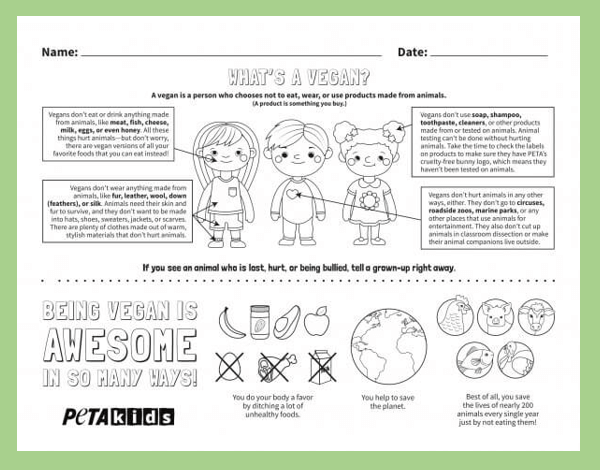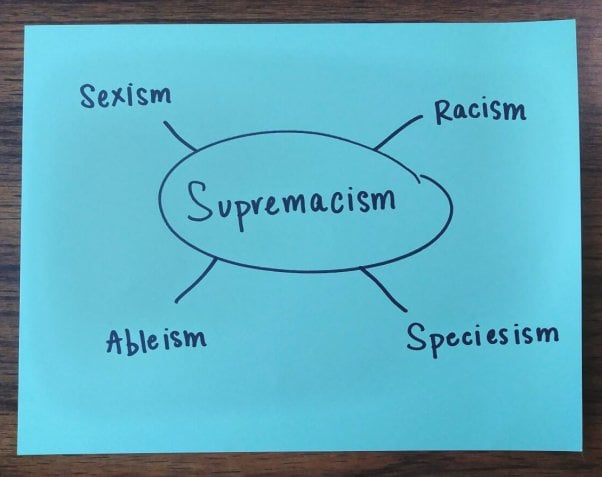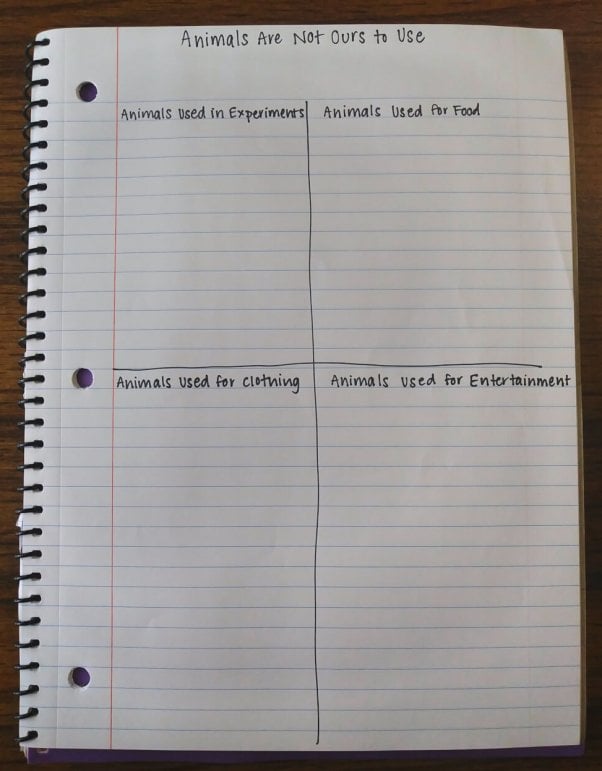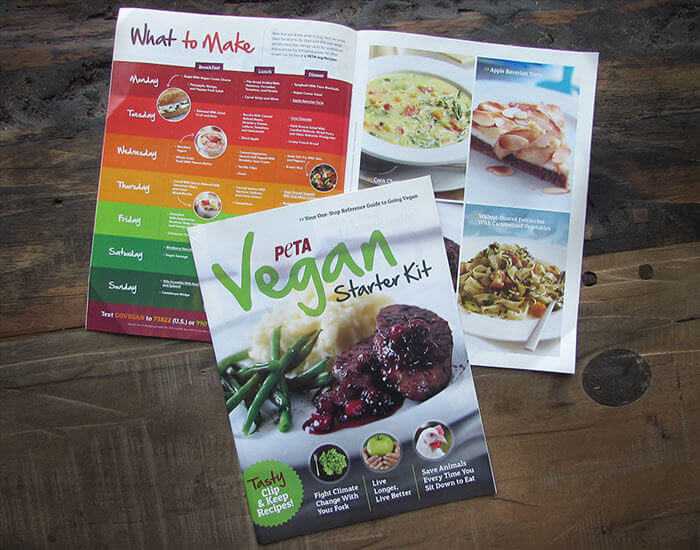What’s a Vegan? Activities to Answer This Question for Students of All Ages
TeachKind regularly uses the word “vegan.” We define it within the context of our monthly rescue stories, we offer dozens of lessons and activities about the importance of going vegan, and we even have a vegan lifestyle section just for teachers. As a humane educator, you may use the term often in your classroom. But some students may still be left scratching their heads, wondering what exactly a vegan is and why someone would choose that lifestyle. Use the following information and resources to answer this question accurately and effectively for students at every grade level.
Grades K-2
Young children are unapologetically inquisitive, so chances are that your students have already asked you, “What’s a vegan?” Answer all their questions concerning why we don’t eat animals with the vibrant and entertaining children’s book V Is for Vegan: The ABCs of Being Kind by acclaimed author, artist, and former classroom teacher Ruby Roth.
With playful illustrations and a familiar rhyme scheme, V Is for Vegan uses the ABCs to spell out compassion for animals in terms that children can understand. Humorous, informative, and at times tender, this charming children’s book will captivate your students while showing them simple yet effective ways they can make the world a safer, happier place for all individuals. The rhyming text is enjoyable, so it may be a good idea to read it all the way through first without stopping so that students can appreciate the overall sound of the book. Then read it aloud a second time and pause to ask students the following questions at the letters below to guide their thinking and build empathy:
- A: Would you eat a dog or a cat? Then should we eat chickens, pigs, cows, and other animals? (Answer for homeschool teacher: No, all animals feel pain when they get hurt, feel scared when they’re in danger, and want to live. Answer for public school teachers: There are plenty of foods to eat that don’t come from animals.)
- C: Why do some animals have fur? Why do some have feathers? What things do humans have to keep us warm that aren’t taken from animals? (Answer: Animals have fur and feathers to stay warm and dry. Humans have clothes, blankets, and other things made from materials that don’t come from animals to keep us warm.)
- D: Look at the baby cow. How do you think she feels? Why? (Answer: She feels angry because a human has taken the milk that was made just for her.)
- I: What should you do if you see an insect in our classroom or in your home? (Answer: Tell an adult so that the insect can be humanely trapped and released outdoors.)
- R: Do you have animal companions at home? How do you help take care of them? (Answers will vary.)
- U: How do you think the turtle and the fish feel about all the garbage in the ocean? (Answer: They’re sad that their home is full of trash. Trash is dangerous for animals and can make them sick.)
- V: What are some of your favorite vegetables? (Answers will vary.)
After the reading, have students discuss ways they’ve helped animals. Perhaps they’ve been involved in the rescue of a wild animal, such as a bird or a squirrel. Maybe their animal companion was adopted from an open-admission shelter. Explain to students that one of the easiest and most effective ways we can all help animals every day is to avoid eating them.
Grades 3-5
Delve deeper into the issue of using animals for food, clothing, and more with Roth’s Vegan Is Love: Having Heart and Taking Action.
With her special brand of gentle candor, Roth treats a controversial subject with care and sensitivity, bring[ing] into sharp focus what it means to “put our love into action.” The message transcends mere food philosophy to encompass the personal agency of people—big and small—in creating a more sustainable and compassionate world.
As you read, use the following questions to guide students’ thinking and build empathy:
- Pages 3 and 4 (Living With Love—Clothing): Why do animals need their fur, feathers, and skin? What things do humans have to keep us warm that aren’t taken from animals? (Answer: Animals need their skins and feathers to keep them warm and dry, to help them fly, and to survive. Humans have clothes, blankets, and other things made from materials that don’t come from animals to keep us warm.)
- Pages 5 and 6 (Animal Testing): What’s wrong with the animals here? (Answer: They’re in small, empty cages. They look scared and sad, and some of them are hurt.)
- Pages 7–9 (Roadside Zoos): How would you feel if you could never leave your bedroom or your house? (Answers will vary.)
- Pages 11–14 (The Circus): How do you think the elephant here feels? (Answer: The elephant feels sad and scared. She doesn’t want to be whipped by the ringleader.) How can we learn about wild animals without going to roadside zoos, aquariums, or other places that hold them captive? (Answer: We can read about them in books and on the computer, watch videos online, and watch nature documentaries.)
- Pages 15–20 (Racing, Hunting, Bullfights, and Rodeos): What are some fun things we can do that don’t use animals? (Answers will vary.)
- Pages 21 and 22 (Eating With Love—Health): What does it mean to be an herbivore? (Answer: Herbivores eat only plants.)
After the reading, have students respond to the question posed at the end of the book, “What kind of person do I want to be?” Have them write their responses on a blank sheet of paper, citing specific information from the text. For example, they may write that they want to be the kind of person who doesn’t go to circuses, because they learned that elephants and other animals forced to perform are abused if they don’t do tricks.
TeachKind’s “What’s a Vegan?” coloring sheet is perfect for elementary school students of all ages. It not only defines the word “vegan” succinctly but also uses kid-friendly language to explain the reasons why a person should go vegan. Have younger students follow along as you read each paragraph aloud, or invite older students to take turns reading to each other. Then have them color in the pictures as they enjoy a healthy vegan snack or watch inspiring rescue story videos.
Download TeachKind’s “What’s a Vegan?” coloring sheet!
Be sure to check out Ruby Roth’s other book,
That’s Why We Don’t Eat Animals: A Book About Vegans, Vegetarians, and All Living Things.
Grades 6-12
Define Supremacism
Older students may be more familiar with what it means to be vegan but may not know that the issue of using animals is multifaceted. Begin by having students create a web with the word “supremacism” in the middle and the words “sexism,” “racism,” “ableism,” and “speciesism” stemming from the center. If they have access to the internet, have them work in small groups to define these terms in their own words using online resources. If the internet isn’t available, define the terms by discussing them as a class. Students are likely to know what sexism and racism are, so use their prior knowledge and understanding of these concepts to guide them in defining “ableism” and then “speciesism.” Then ask them to discuss other forms of supremacism (classism, ageism, etc.) and what all these forms of systemic oppression have in common.
- Sexism: prejudice, stereotyping, or discrimination, typically against women, on the basis of sex
- Racism: prejudice, discrimination, or antagonism directed against someone of a different color based on the belief that one’s own color is superior
- Ableism: discrimination in favor of able-bodied people
- Speciesism: the assumption of human superiority, leading to the exploitation of animals

Discuss Solutions
Next, discuss how people have combatted and continue to combat the forms of supremacism outlined in the web. When discussing sexism, for example, students may cite women’s suffrage, campaigns for reproductive rights and equal pay, and the various waves of feminism throughout history as efforts to reduce sexism in society. When discussing racism, be sure to talk about the abolitionist movement, the civil rights movement, and the Black Lives Matter movement. For ableism, students can point out the growing representation of people with disabilities in popular media and laws that protect people with disabilities from discrimination in the workplace and in educational institutions. Students are also encouraged to evaluate the effectiveness of these efforts and to discuss what a solution to each of the forms of supremacism might look like in the future.
Finally, when addressing speciesism, students may point out that it’s illegal to hurt certain animals. Dogs and cats enjoy some protections under the law. However, cows, pigs, chickens, and other animals aren’t granted the same protections. For example, branding cows with hot irons is common practice on many factory farms, but the thought of a dog being branded repulses most people. Challenge students by asking, “Isn’t that speciesism—protecting some individuals but not all based on their species?” Students may be stumped by this, but allow them to brainstorm, either in small groups or as a whole class. Be sure that they eventually come to the conclusion that the only way to counter speciesism is to abstain from consuming anything made using animals. Reveal to students that this ethical lifestyle choice is effectively vegan.
Research and Argue the Claim
Now share with students PETA’s motto: “Animals are not ours to experiment on, eat, wear, use for entertainment, or abuse in any other way.” Point out that a vegan lifestyle extends far beyond dietary choices—vegans do abstain from eating animal-derived foods, but they also refuse to use personal-care and household products tested on animals and don’t wear clothing made from animal skins. Plus, vegans avoid forms of entertainment that exploit animals for profit—such as circuses, roadside zoos, marine parks, and rodeos—and oppose all other forms of animal abuse, like chaining dogs and declawing cats.
Split students into four groups and have each research one of the following issues, using a four-square graphic organizer (like the one pictured below) to record their notes:
- Animals used in experiments
- Animals used for food
- Animals used for clothing
- Animals used for entertainment

Have the groups briefly explain why vegans avoid using animals in each context. As each group presents, the rest of the class can take notes in their graphic organizers to use in addressing the writing prompt, “Is it ethical to consume animal-derived ‘products’?” Students can use TeachKind’s debate kit and the notes in their webs and graphic organizers to write a well-developed persuasive essay detailing their response.
Be sure to order a class set of PETA’s Vegan Starter Kits to help your students make a smooth transition to their new vegan lifestyle.

Like these ideas? Sign up for TeachKind News!
By submitting this form, you’re acknowledging that you have read and agree to our privacy policy and agree to receive e-mails from us.





